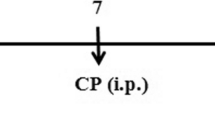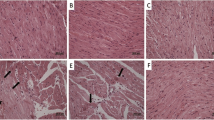Abstract
Cyclophosphamide causes lung injury in rats through its ability to generate free radicals with subsequent endothelial and epithelial cell damage. In order to observe the protective effects of a potent anti-inflammatory antioxidant, curcumin (diferuloyl methane) on cyclophosphamide-induced early lung injury, healthy pathogen free male Wistar rats were exposed to 20 mg/100 g body weight of cyclophosphamide, intraperitoneally as a single injection. Prior to cyclophosphamide intoxication oral administration of curcumin was performed daily for 7 days. At various time intervals (2, 3, 5 and 7 days post insult) serum and lung samples were analyzed for angiotensin converting enzyme, lipid peroxidation, reduced glutathione and ascorbic acid. Bronchoalveolar lavage fluid was analyzed for biochemical constituents. The lavage cells were examined for lipid peroxidation and glutathione content. Excised lungs were analyzed for antioxidant enzyme levels. Biochemical analyses revealed time course increases in lavage fluid total protein, albumin, angiotensin converting enzyme (ACE), lactate dehydrogenase, N-acetyl-β-D-glucosaminidase, alkaline phosphatase, acid phosphatase, lipid peroxide levels and decreased levels of glutathione (GSH) and ascorbic acid 2, 3, 5 and 7 days after cyclophosphamide intoxication. Increased levels of lipid peroxidation and decreased levels of glutathione and ascorbic acid were seen in serum, lung tissue and lavage cells of cyclophosphamide groups. Serum angiotensin converting enzyme activity increased which coincided with the decrease in lung tissue levels. Activities of antioxidant enzymes were reduced with time in the lungs of cyclophosphamide groups. However, a significant reduction in lavage fluid biochemical constituents, lipid peroxidation products in serum, lung and lavage cells with concomitant increase in antioxidant defense mechanisms occurred in curcumin fed cyclophosphamide rats. Therefore, our results suggest that curcumin is effective in moderating the cyclophosphamide induced early lung injury and the oxidant-antioxidant imbalance was partly abolished by restoring the glutathione (GSH) with decreased levels of lipid peroxidation.
Similar content being viewed by others
References
Batist G, Andrews JL Jr: Pulmonary toxicity of antineoplastic drugs. J Am Med Assoc 246: 1449–1453, 1981
Collis CH, Wilson CM, Jones JM: Cyclophosphamide induced lung damage in mice: Protection by a small preliminary dose. Br J Cancer 41: 901–907, 1980
Gould VE, Miller J: Sclerosing alveolitis induced by cyclophosphamide. Am J Pathol 81: 513–530, 1975
Cooper JAD Jr, White DA, Matthay RA: Drug induced pulmonary disease. Am Rev Respir Dis 133: 321–340, 1986
Kanekal S, Fraiser L, Kehrer JP: Pharmacokinetics, metabolic activation and lung toxicity of cyclophosphamide in C57/B16 and ICR mice. Toxicol Appl Pharmacol 114: 1–8, 1992
Patel JM: Metabolism and pulmonary toxicity of cyclophosphamide. Pharmac Ther 47: 137–146, 1990
Srivastava R, Srimal RC: Modification of certain inflammation-induced biochemical changes by curcumin. Indian J Med Res 81: 215–223, 1985
Nishigaki I, Kuttan R, Oku H, Ashoori F, Abe H, Yagi K: Suppressive effect of curcumin on lipid peroxidation induced in rats by carbon tetrachloride or60co-irradiation. J Clin Biochem Nutr 13: 23–29, 1992
Sharma OP: Antioxidant activity of curcumin and related compounds. Biochem Pharmacol 25: 1811–1812, 1976
Pulla Reddy, A Ch, Lokesh BR: Studies on spice principles as antioxidants in the inhibition of lipid peroxidation of rat liver microsomes. Mol Cell Biochem 111: 117–124, 1992
Venkatesan N, Chandrakasan G: Cyclophosphamide induced early biochemical changes in lung lavage fluid and alterations in lavage cell function. Lung 172: 147–158, 1994
Soudamini KK, Kuttan R: Chemoprotective effect of curcumin against cyclophosphamide toxicity. Indian J Pharm Sci 54: 213–217, 1992
Lowry OH, Rosebrough NJ, Farr AL, Randall RJ: Protein measurement with the Folin phenol reagent. J Biol Chem 193: 265–275, 1951
Varley H: Practical Clinical Biochemistry. CBS Publishers and Distributors, Delhi, 1988, pp 243–244
Cushman DW, Cheung HS: Spectrophotometric assay and properties of the angiotensin converting enzyme of rabbit lung. Biochem Pharmacol 20: 1637–1647, 1971
King J: Practical Clinical Enzymology. Von Nostrand D. Company, London, 1965, pp 106–107
Moore JC, Morris JW: A simple automated colorimetric method for determination of N-acetyl-β-D-glucosaminidase. Ann Clin Biochem 19: 157–159, 1982
King J: Practical Clinical Enzymology. Von Nostrand D. Company, London, 1965, pp 264–265
Cynamon HA, Isenberg JN, Nguyenco H: Erythrocyte malondialdehyde releasein vitro: a functional measure of vitamin E status. Clin Chim Acta 151: 169–176, 1985
Hogberg J, Larson RE, Kristoferson A, Orrenius S: NADPH-dependent reductase solubilized from microsomes by peroxidation and its activity. Biochem Biophys Res Commun 56: 836–842, 1974
Moron LS, Depierre JW, Mannerwik B: Levels of glutathione, glutathione reductase and glutathione S-transferase activities in rat lung and liver. Biochim Biophys Acta 582: 67–78, 1979
Omaye ST Turnbull JD, Sauberlich HE: Selected methods for the determination of ascorbic acid in animal cells, tissues and fluids. In: D.B. McCormick and L.D. Wright (eds). Methods in Enzymology. Academic Press, New York, 1979, pp 7–8
Ells HA, Kirkman HN: A colorimetric method, for assay of erythrocytic glucose-6-phosphate dehydrogenase. Proc Soc Exptl Biol Med 106: 607–609, 1961
Misra HP, Fridovich I: The role of superoxide anion in the autooxidation of epinephrine and a simple assay for superoxide dismutase. J Biol Chem 247: 3170–3175, 1972
Takahara S, Hamilton BH, Nell JV, Kobara TY, Ogura Y, Nishimura ET: Hypocatalasemia: a new genetic carrier state. J Clin Invest 29: 610–619, 1960
Necheles TF, Boles TA, Allen DM: Erythrocyte glutathione peroxidase deficiency and hemolytic disease of the newborn infant. J Pediatr 72: 319–324, 1968
Habig WH, Pabst MJ, Jakoby WB: Glutathione S-transferases. The first enzymatic step in mercapturic acid formation. J Biol Chem 249: 7130–7139, 1974
Copland GM, Kolin A, Schulman HS: Fatal pulmonary intra-alveolar fibrosis after paraquat ingestion. N Engl J Med 291: 290–292, 1974
Rebello G, Mason JK: Pulmonary histological appearances in fatal paraquat poisoning. Histopathology 2: 53–66, 1978
Vijeyaratnam GS, Corrin B: Experimental paraquat poisoning. A histopathological and electron-optical study of the changes in the lung. J Pathol 103: 123–129 1971
Giri SN, Schwartz LW, Hollinger MA, Freywald ME, Schiedt MJ Zuckerman JE: Biochemical and structural alterations of hamster lungs in response to intratracheal administration of bleomycin. Exp Mol Pathol 33: 1–14, 1980
Hampson ECGM, Eyles DW, Pond SM: Effect of paraquat on canine bronchoalveolar lavage fluid. Toxicol Appl Pharmacol 98: 206–215, 1989
Driscoll KE, Maurer JK, Poynter J, Higgins, J, Asquith T, Miller NSC: Stimulation of rat alveolar macrophage fibronectin release in a cadmium chloride model of lung injury and fibrosis. Toxicol Appl Pharmacol 116: 30–37, 1992
Schultze AE, Wagner JG, White SM, Roth RA: Early indications of monocrotaline pyrrole-induced lung injury in rats. Toxicol Appl Pharmacol 109: 41–50, 1991
Lew DB, Chodimella V, Murlas CG: Guinea pig ozone-induced airway hyperreactivity is associated with increased N-acetyl-β-D-glucosaminidase activity in bronchoalveolar lavage fluid. Lung 168: 273–283, 1990
Cochrane CG: Immunologic tissue injury mediated by neutrophilic leukocytes. Adv Immunol 9 97–167, 1968
Fox RB, Hoidal JR, Brown DM, Repine JE: Pulmonary inflammation due to oxygen toxicity: Involvement of chemotactic factors and polymorphonuclear leukocytes. Am Rev Respir Dis 123: 521–523, 1981
Weiss SJ: Tissue destruction of neutrophils. N Engl J Med 320: 365–376, 1989
Cooper JAD Jr, Merrill WW, Reynolds HY Cyclophosphamide modulation of bronchoalveolar cellular populations and macrophage oxidative metabolism: Possible mechanisms of pulmonary pharmacotoxicity. Am Rev Respir Dis 134: 108–114, 1986
Srimal RC, Dhawan BN: Pharmacology of diferuloyl methane (curcumin), a non-steroidal anti-inflammatory agent. J Pharm Pharmacol 25: 447–452, 1973
Deodhar SD, Sethi R, Srimal RC: Preliminary study on antirheumatic activity of curcumin (diferuloyl methane). Indian J Med Res 71: 632–634, 1980
Patel JM, Block ER, Hood CI: Biochemical indices of cyclophosphamide-induced lung injury. Toxicol Appl Pharmacol 76: 128–138, 1984
Patel JM: Stimulation of cyclophosphamide-induced pulmonary microsomal lipid peroxidation by oxygen. Toxicology 45: 79–91, 1987
Patel JM, Block ER: Cyclophosphamide induced depression of the antioxidant defense mechanisms of the lung. Exptl Lung Res 8: 153–165, 1985
Author information
Authors and Affiliations
Rights and permissions
About this article
Cite this article
Venkatesan, N., Chandrakasan, G. Modulation of cyclophosphamide-induced early lung injury by curcumin, an anti-inflammatory antioxidant. Mol Cell Biochem 142, 79–87 (1995). https://doi.org/10.1007/BF00928916
Received:
Accepted:
Issue Date:
DOI: https://doi.org/10.1007/BF00928916




